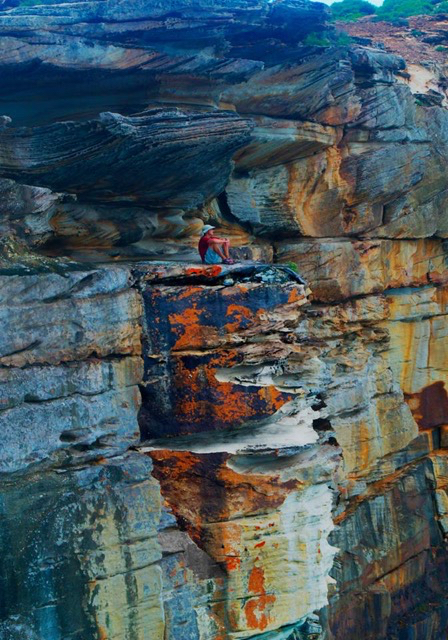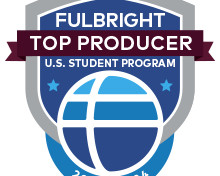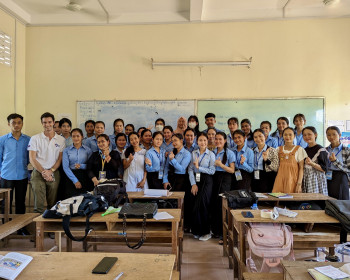Pio Log Features “Living Abroad”
Open gallery

Skywalking
My otherworldly journey to the top of Australia’s highest mountain
By Caleb Diehl /// Pio Log Staff Writer
Last Wednesday, I found myself on a bus full of Australian schoolchildren, en route to the highest mountain on the continent. We were traveling from the lakeside town of Jindabyne to Thredbo, the sleepy mountain village where I would begin my hike to the summit. I sat in the front row across from the driver, Wally, quickly establishing myself as the least cool kid on the bus. At the first stop, we picked up four-, five-, six- and seven-year-olds in green and white uniforms.
“Can I sit by you?” a boy asked the girl behind me.
“No, you absolutely may not,” she said.
The girl across from me, who couldn’t have been more than six, offered some background. “They kissed yesterday.”
Another sandy-haired boy leaned over her seat and pointed at her sketchbook. “Is that your laptop?”
She shot back, “Would you like me to pull up a picture of you nude?”
Let me be clear: this trip was not any great mountaineering expedition. Summiting Australia’s highest mountain is a bit like winning a race walking competition. Australia is the flattest continent on Earth. Making the summit of Mt. Koscioscko is as easy as driving to Thredbo, catching a chairlift past all the steep parts, and meandering six kilometers over a sturdy metal walkway.
But I wasn’t taking the easy way. My route would involve open air cooking, 1,000 more vertical meters on foot and a much greater chance of electrocution.
To start, I didn’t have a car. Instead, I caught a coach from Canberra to Jindabyne. Pulling away from Canberra felt like escaping the Earth’s gravity. For a week, the sprawling office park that passed as a city had sucked hours from me as I wandered from museum to gallery along bland sandstone paths and along Lake Burley-Griffin. It was beautiful in a way, in the way an airport terminal is beautiful.
The national park service office at Jindabyne doubled as the town center, ringed by the Woolworths supermarket, a café, and the elementary school. As I passed a picnic table, a bearded sixty-something man called out to me.
“You looking for the bus to Thredbo?”
His name was Pete. I sat down with him and we talked, mostly about how screwed the United States is and how much money we owe other countries and how China is going to take over the world. After a few minutes, Wally pulled up and sat next to us. He told us about his brand-new snowy white coach with a yellow “school bus” sign.
“White for the snowy mountains,” I said. He laughed.
Wally and Pete talked about bus routes for a while. Then Wally said, “We make a stop at the local elementary and at the private school then it’s on to Thredbo.”
“So this is actually a school bus?” I said.
When I got off at Thredbo, the chairlift was shuttered for the day. I began hiking past the tennis courts and bobsled run, past gum trees and stringybarks and sandpaper figs, crossing several grassy ski runs. The push to the top of the chair was so steep I could feel my pack threatening to lift like a balloon off the mountain.
At the top, I arrived on a new planet. I was the only human on this planet, but aliens had hammered together some metal grates for a path. In my head, ground control crackled over the radio and asked me what I saw.
I told them I was in tundra, an expanse of granite boulder piles and scrub that appeared purple and green in the dusk. Black streams cut the vegetation into a labyrinth.
Around 6:30 p.m., the ground control illusion faded as I realized that this was my first solo backpacking trip. That meant I was alone. I was so alone that I would go 17 hours without seeing another human. I would cook alone, sleep alone, wake up alone. There wouldn’t even be one more bus driver to thank. The loneliness sunk upon my shoulders like a second pack.
I camped behind one of the boulders. It didn’t seem to matter which one, as long as it was near a stream. I had just finished cooking dinner when I was discovered by the eye of doom. Purple lighting crackled and struck the ridge above me, as a thunderhead moved directly over my tent, a yellow nylon tube pitched on the moss. This was the roof of Australia, and the clouds loomed inches from my head. I tossed my metal knife behind some rocks and dived into my tent just as the brightest flash illuminated me.
The old rule of estimating the storm’s distance by the space between lighting and thunder did not apply. I was in the storm. One peal of thunder rolled on, not for three seconds, not for five, but on until I thought please stop, please stop, and then for another five seconds.
In the morning I walked to the summit. Backpacking solo gave me time to think, and I thought mostly about why I was solo backpacking. About an hour after I reached the summit, a runner joined me. He cracked open a beer and took a selfie. Later, a parade of day hikers wound its way toward us.
All that lightning and thunder and terror, and here was a mob of half-drunk day hikers reaching the peak just an hour after I did. Many were small children or octogenarians. I felt less like they cheated, and more like they outsmarted me at chess. By the time I broke camp, they were being catapulted to a point 2km behind me. They could explore the range as far and for as long as I could. They could reach the same peaks. They could get the same experience, plus a restaurant meal at either end.
Then I remembered the whole point of backpacking: it takes time. Everything takes longer — lighting the stove, making water safe to drink, falling asleep. I can walk a mile with no pack in 15 minutes. Fully loaded, it takes twice as long. Every task can become dangerous and uncomfortable unless it is done slowly and deliberately. If all I wanted to do was see more than anyone around me, I would take a helicopter.
Thanks to capitalism, becoming the highest thing on a continent is a thoughtless activity. Even on Mt. Everest, commercial tour companies transport the rich worry free, using sherpas to ferry their luggage. In the future, a teleporter will just beam people to the highest peaks of every continent in the morning, and beam them to Mars for lunch.
They won’t know what they missed.
With that in mind, I set off on the main range track, down a long staircase, over a saddle and around the bend to a sweeping view of a glacial lake carved out of the rock, entombed hundreds of feet below vast monoliths. The water was so shiny and still it could have been gelatin. I continued, straddling ridges of windswept feldmark like those made famous in The Lord of the Rings trilogy. It was like bouncing along a knife-edge, on either side a plunge into rocky crags and spectacular cloud formations. I was floating free.
If that all sounds romantic, you haven’t heard of bushflies. Every step, I was dogged by hordes of the oversized Australian demon-insect, bent on penetrating my ears, nose and eyeballs. I’m no scientist, but I made two discoveries about their anatomy: they are resistant to swatting and deet. Straight 100 percent deet.
I pressed on along the ridge until I spotted several clouds dead ahead and moving fast. They were sweeping and twirling over my ridge like a tornado, and soon we would intersect. Right behind them were big grey clouds, like the ones that had transported lightning and thunder into my camp. I had to get out.
I skipped down the ridge, acutely aware of the pile of $1 and $2 Australian coins jiggling in my pocket. The thunder boomed. As I powerwalked, I measured myself against the surrounding rocks and came to a sobering conclusion. If lightning struck, I was the easiest target, the highest point around.
I beat the clouds, and kept ahead for a while, until I reached the junction of the main range track and Mt. Kosicaodfianko trail. There, a cloud engulfed me. Suddenly my world was misty and white and ten feet in any direction. Beyond that, every object was blurry, as if it was underwater. I couldn’t see the lake, or my campsite, only the metal path, and when the thunder rolled again, I recalled the conductive qualities of metal. I picked up my pace, aiming for the tall metal poles that supported the ski lifts.
At any moment, I thought, my path to safety could become a live wire. But stepping off it meant losing myself in a misty world forever. It seems melodramatic now, but when I was alone, it was real. The only thing to do was walk forward in a straight line, so I did it, not out of courage but because it was the only thing to do. This, I realized, was the second great joy of backpacking. It made you do courageous things, not because you had an epiphany or ripped off your shirt to reveal an “S,” but because you had to do them.
At the bottom of the mountain, I walked toward the sign that read “pizza.” My legs felt like phantom legs. I smelled like people smell after two consecutive bus rides and a night in the bush. Inside, I asked the cashier, “You have pizza here?”
“We better,” she said. “We’re a pizza parlor.”
I lit up like a lightning rod.
I used the map at the tourist information center to find my way to the Youth Hostel. It was ghostly quiet. I checked into my room, where there was a grey Osprey pack and toiletries scattered across the floor. I had planned the Thredbo trip in about a day and a half, and planned is a generous word. I hadn’t really planned for either camping or hostelling. One significant omission was soap. In the shower that night, I lathered myself in hand soap from the dispenser.
I sprawled on a couch in the living room to read. The room looked like a ski lodge, with plush couches and great oak beams and a giant chess set. Five or six Australian mountain bikers filled in the couches around the chess set to drink rum. They were middle-aged, clean shaven and corporate, like they all had nine to five desk jobs and titles like “systems analyst” and “data engineer.” One of them offered me a Tim Tam.
“I can’t believe you bloody tried to follow this old bloke down the mountain,” his friend was saying.
“At least I’m not this guy,” he said, gesturing to the man in the kitchen. “Winding up upside down in a tree.”
“How’d he end up in a tree?” I asked. I found out that the tree scenario was a bit exaggerated, and that the unfortunate biker had merely nipped a tree around a tight turn. I also found out that the six men were from Newcastle, a suburb of Sydney. They were the most Australian Australians I had met. They recommended the beaches at Newcastle. Aside from one or two recently active sharks, the conditions were rather nice.
At 7:00 a.m. the next morning, I checked out. Right before the bus stop, I realized I had forgotten to brush my teeth. I did it then, in the grassy square at the center of the resort village in a foggy jungle. I felt homeless. It didn’t matter anymore where or when I did things. There was no going out and coming home. Everywhere I went, I was passing through. I spit onto the grass.
At the bus stop I was met by a thin bespectacled man with sharp blue eyes. He was clutching the same Osprey pack I had seen in my room. “Looking for the school bus?” he said.
“Yeah.” We talked all the way back to Jindabyne. He was an Englishman, from Canterbury, backpacking down the Australian East Coast. He had attended Eaton and later earned an M.BA He struck me as the type who wouldn’t understand a thing about backpacking, or being outside.
He proved me wrong. The day before I reached Mt. Kosicaisko, he had hiked up the same track, along the main range and down the mountain via dead horse loop, a more rambling route than the one I had taken. It totaled 47km. In one day he covered more ground than I did in two. The whole ride, as we talked, I kept staring at the mountainside and repeating the number in my head.
He had arrived in Thredbo on Monday and stayed for the week. He rode up with Lucas, a Swiss mountain biker whom I met at the hostel in Canberra.
We transferred onto our bus to Cooma, which was returning from a school run. We were the only passengers.
We separated at Cooma. He was staying for the night and I was heading back to Canberra. I said goodbye.
“Wait,” he said. “I don’t know your name.”
“I’m Caleb.”
“George.” It like a bit of old information. From the minute he mentioned Lucas, we were old friends, connected by the underground network of backpackers, the community that operates beneath the people speeding to and from tourist landmarks in their cars and planes and clean, self-contained hotel rooms. Lucas’s name was a sort of password into this world. By knowing him, I proved I was part of the network. It didn’t matter how many Ks I did each day, where I stayed or how I smelled. I was always passing through, and that was good enough.
Students share their Overseas experience through the “Living Abroad” feature in the Pio Log. Check out more stories HERE!
More Overseas and Off-Campus Programs Stories
Overseas and Off-Campus Programs is located in room 206 of Albany Quadrangle on the Undergraduate Campus.
MSC: 11
email overseas@lclark.edu
voice 503-768-7295
fax 503-768-7300
Director Blythe Knott
Overseas and Off-Campus Programs
Lewis & Clark
615 S. Palatine Hill Road MSC 11
Portland OR 97219

